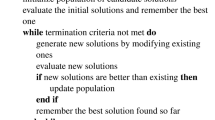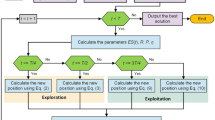Abstract
This study proposes a novel population-based metaheuristic algorithm called the Gazelle Optimization Algorithm (GOA), inspired by the gazelles’ survival ability in their predator-dominated environment. Every day, the gazelle knows that if it does not outrun and outmaneuver its predators, it becomes meat for the day, and to survive, the gazelles have to escape from their predators consistently. This information is vital to proposing a new metaheuristic algorithm that uses the gazelle’s survival abilities to solve real-world optimization problems. The exploitation phase of the algorithm simulates the gazelles grazing peacefully in the absence of the predator or while the predator is stalking it. The GOA goes into the exploration phase once a predator is spotted. The exploration phase consists of the gazelle outrunning and outmaneuvering the predator to a safe haven. These two phases are iteratively repeated, subject to the termination criteria, and finding optimal solutions to the optimization problems. The robustness and efficiency of the developed algorithm as an optimization tool were tested using benchmark optimization test functions and selected engineering design problems (fifteen classical, ten composited functions, and four mechanical engineering design problems). The results of the GOA are compared with nine other state-of-the-art algorithms. The simulation results obtained confirm the superiority and competitiveness of the GOA algorithm over nine state-of-the-art algorithms available in the literature. Also, the standard statistical analysis test carried out on the results further confirmed the ability of GOA to find solutions to the selected optimization problems. It also showed that GOA performed better or, in some cases, was very competitive with some state-of-the-art algorithms. Also, the results show that GOA is a potent tool for optimization that can be adapted to solve problems in different optimization domains.














Similar content being viewed by others
Explore related subjects
Discover the latest articles, news and stories from top researchers in related subjects.Data availability statements
Data is available from the authors upon reasonable request.
References
Abed-alguni BH, Paul D (2022) Island-based Cuckoo Search with elite opposition-based learning and multiple mutation methods for solving optimization problems. Soft Comput 26(7):3293–3312
Abed-Alguni BH, Paul D, Hammad R (2022) Improved Salp swarm algorithm for solving single-objective continuous optimization problems. Appl Intell. https://doi.org/10.1007/s10489-022-03269-x
Abualigah L, Diabat A, Mirjalili S, Abd Elaziz M, Gandomi AH (2021) The arithmetic optimization algorithm. Comput Methods Appl Mech Eng 376:113609
Agushaka JO, Ezugwu AE (2020). Diabetes classification techniques: a brief state-of-the-art literature review. In: International Conference on Applied Informatics (pp. 313–329). Ogun: Springer, Cham
Agushaka JO, Ezugwu AE (2021) Advanced arithmetic optimization algorithm for solving mechanical engineering design problems. PLoS ONE. https://doi.org/10.1371/journal.pone.0255703
Agushaka JO, Ezugwu AE (2022) Influence of probability distribution initialization methods on the performance of advanced arithmetic optimization algorithm with application to unrelated parallel machine scheduling problem. Concurr Comput Pract Exper 34:e6871
Agushaka JO, Ezugwu AE, Abualigah L (2022) Dwarf Mongoose Optimization Algorithm. Comput Methods Appl Mech Eng 391:114570
Agushaka J, Ezugwu A (2020) Influence of initializing krill herd algorithm with low-discrepancy sequences. IEEE Access 8:210886–210909
Akay B, Karaboga D (2012) A modified artificial bee colony algorithm for real-parameter optimization. Inf Sci 192:120–142
Akay B, Karaboga D (2012) Artificial bee colony algorithm for large-scale problems and engineering design optimization. J Intell Manuf 23(4):1001–1014
Alatas B (2011) ACROA: artificial chemical reaction optimization algorithm for global optimization. Expert Syst Appl 38(10):13170–13180
Arora S, Singh S (2019) Butterfly optimization algorithm: a novel approach for global optimization. Soft Comput 23(3):715–734
Atashpaz-Gargari E, Lucas C (2007). Imperialist competitive algorithm: an algorithm for optimization inspired by imperialistic competition. In 2007 IEEE congress on evolutionary computation (pp. 4661–4667). Ieee
Biswas A, Mishra K, Tiwari S, Misra A (2013). Physics-inspired optimization algorithms: a survey. Journal of Optimization, 2013
Braik MS (2021) Chameleon swarm algorithm: a bio-inspired optimizer for solving engineering design problems. Expert Syst Appl 174:114685
Coello C (2000) Use of self-adaptive penalty approach for engineering optimization problems. Comput Ind 41(2):113–127
Dorigo, M., & Di Caro, G. (1999). Ant colony optimization: a new meta-heuristic. In: Proceedings of the 1999 congress on evolutionary computation-CEC99 (Cat. No. 99TH8406) (Vol. 2) (pp. 1470–1477). IEEE
Einstein A (1956) Investigations on the Theory of the Brownian Movement. Courier Corporation, US
Estes R (2020, May 2). Gazelle. Retrieved from Encyclopedia Britannica: https://www.britannica.com/animal/gazelle
Ezugwu AE (2020) Nature-inspired metaheuristic techniques for automatic clustering: a survey and performance study. SN Applied Sciences 2(2):273
Ezugwu AE, Adeleke OJ, Akinyelu AA, Viriri S (2020) A conceptual comparison of several metaheuristic algorithms on continuous optimization problems. Neural Comput Appl 32(10):6207–6251
Ezugwu AE, Akutsah F (2018) An improved firefly algorithm for the unrelated parallel machines scheduling problem with sequence-dependent setup times. IEEE Access 6:54459–54478
Ezugwu AE, Agushaka JO, Abualigah L, Mirjalili S, Gandomi AH (2022) Prairie dog optimization algorithm. Neural Comput Appl. https://doi.org/10.1007/s00521-022-07530-9
Ezugwu AE, Shukla AK, Nath R, Akinyelu AA, Agushaka JO, Chiroma H, Muhuri PK (2021) Metaheuristics: a comprehensive overview and classification along with bibliometric analysis. Artif Intell Rev 54(6):4237–4316
Faramarzi A, Heidarinejad M, Mirjalili S, Gandomi AH (2020) Marine predators algorithm: a nature-inspired metaheuristic. Expert Syst Appl 152:113377
FitzGibbon, C. D., & Lazarus, J. (1995). Antipredator behavior of Serengeti ungulates: individual differences and population consequences. Serengeti II: Dynamics, management, and conservation of an ecosystem, 274–296
Hassan BA (2021) CSCF: a chaotic sine cosine firefly algorithm for practical application problems. Neural Comput Appl 33(12):7011–7030
Holland, J. H. (1975). Adaptation in natural and artificial systems. University of Michigan Press. (Second. Michigan: University of Michigan Press. (Second edition: MIT Press, 1992)
Houssein EH, Saad MR, Hashim FA, Shaban H, Hassaballah M (2020) Lévy flight distribution: a new metaheuristic algorithm for solving engineering optimization problems. Eng Appl Artif Intell 94:103731
Humphries NE, Queiroz N, Dyer JR, Pade NG, Musyl MK, Schaefer KM, Sims DW (2010) Environmental context explains Lévy and Brownian movement patterns of marine predators. Nature 465(7301):1066–1069
Ibrahim A, Tawhid M, Ward R (2020) A binary water wave optimization for feature selection. Int J Approx Reason 120:74–91
Kaveh A, Eslamlou A (2020) Water strider algorithm: a new metaheuristic and applications. Structures 25:520–541
Kaveh A, Hamedani KB, Kamalinejad M (2022) Improved slime mould algorithm with elitist strategy and its application to structural optimization with natural frequency constraints. Comput Struct 264:106760
Kaveh A, Talatahari S, Khodadadi N (2020). Stochastic paint optimizer: theory and application in civil engineering. Engineering with Computers, 1–32
Kennedy J, Eberhart R (1995). Particle swarm optimization. In: Proceedings of ICNN’95-international conference on neural networks (Vol. 4) (pp. 1942–1948). IEEE
Kirkpatrick S, Gelatt Jr CD, Vecchi MP (1983) Optimization by simulated annealing. Science 220(4598):671–680
Lee KS, Geem ZW (2005) A new meta-heuristic algorithm for continuous engineering optimization: harmony search theory and practice. Comput Methods Appl Mech Eng 194(36–38):3902–3933
Liu H, Zhang X, Liang H, Tu L (2020) Stability analysis of the human behavior-based particle swarm optimization without stagnation assumption. ExpertSystAppl 159:113638
Mantegna RN (1994) Fast, accurate algorithm for numerical simulation of Levy stable stochastic processes. Phys Rev E 49(5):4677
Mezura-Montes E, Coello CA (2005). Useful infeasible solutions in engineering optimization with evolutionary algorithms. In: Mexican international conference on artificial intelligence (pp. 652–662). Berlin, Heidelberg: Springer
Mirjalili S (2016) SCA: a sine cosine algorithm for solving optimization problems. Knowl-Based Syst 96:120–133
Mirjalili S, Gandomi A, Mirjalili S, Saremi S, Faris H, Mirjalili S (2017) Salp swarm algorithm: a bioinspired optimizer for engineering design problems. Adv Eng Software 124:163–191
Mirjalili S, Mirjalili SM, Lewis A (2014) Grey wolf optimizer. Adv Eng Softw 69:46–61
Mohammadi F, Amini M, Arabnia H (2020). Evolutionary computation, optimization, and learning algorithms for data science. Optimization, Learning, and Control for Interdependent Complex Networks.Cham, Switzerland: Springer, 37–65
Moosavi S, Bardsiri V (2019) Poor and rich optimization algorithm: a new human-based and multi populations algorithm. Eng Appl Artif Intel 86:165–181
Nadimi-Shahraki MH, Taghian S, Mirjalili S (2021) An improved grey wolf optimizer for solving engineering problems. Expert Syst Appl 166:113917
Olson KA, Larsen EA, Mueller T, Leimgruber P, Fuller TK, Schaller GB, Fagan WF (2014) Survival probabilities of adult Mongolian gazelles. J Wildl Manag 78(1):35–41
Omondi, S. (2017, August 1). Gazelle Facts - Animals of the World. Retrieved from WorldAtlas/Environment: https://www.worldatlas.com/articles/gazelle-facts-animals-of-the-world.html
Oyelade ON, Ezugwu AE-S, Mohamed TI, Abualigah L (2022) Ebola optimization search algorithm: A new nature-inspired metaheuristic optimization algorithm IEEE. Access 10:16150–16177
Pelusi D, Mascella R, Tallini L, Nayak J, Naik B, Deng Y (2020) Improving exploration and exploitation via a hyperbolic gravitational search algorithm. Knowl-Based Syst 193:105
Rahkar Farshi T (2021) Battle royale optimization algorithm. Neural Comput Appl 33(4):1139–1157
Rashedi E, Nezamabadi-Pour H, Saryazdi S (2009) GSA: a gravitational search algorithm. Inf Sci 179(13):2232–2248
Rather S, Bala P (2019). Hybridization of constriction coefficient based particle swarm optimization and gravitational search algorithm for function optimization. In: International Conference on Advances in Electronics, Electrical, and Computational Intelligence (ICAEEC- 2019). Elsevier
Rechenberg I (1978). Evolutionary strategies. In simulation methods in medicine and biology, Berlin, Heidelberg, 83–114
Sarzaeim P, Bozorg-Haddad O, Chu X (2018). Teaching-learning-based optimization (TLBO) algorithm. Advanced Optimization by Nature-Inspired Algorithms. Singapore, Asia: Springer, 51–58
Shabani A, Asgarian B, Salido M, Gharebaghi SA (2020) Search and rescue optimization algorithm: a new optimization method for solving constrained engineering optimization problems. Expert Syst Appl 161:113698
Simon D (2008) Biogeography based optimization. IEEE Trans Evol Comput 12(6):702–713
Slowik A, Kwasnicka H (2020) Evolutionary algorithms and their applications to engineering problems. Neural Comput Appl 32(16):12363–12379
Storn R, Price K (1997) Differential evolution–a simple and efficient heuristic for global optimization over continuous spaces. J Global Optim 11(4):341–359
Tzanetos A, Dounias G (2021) Nature inspired optimization algorithms or simply variations of metaheuristics? Artif Intell Rev 54(3):1841–1862
Uymaz SA, Tezel G, Yel E (2015) Artificial algae algorithm (AAA) for nonlinear global optimization. Appl Soft Comput 31:153–171
Wang GG, Guo L, Gandomi AH, Hao GS, Wang H (2014) Chaotic krill herd algorithm. Inf Sci 274:17–34
Xie Q, Cheng G, Zhang X, Peng L (2020) Feature selection using improved forest optimization algorithm. Inf Technol Control 49(2):289–301
Xing B, Gao W (2014). Invasive weed optimization algorithm. Innovative Computational Intelligence: A Rough Guide to 134 Clever Algorithms. Cham, Switzerland:Springer, 177–181
Yang X S, Deb S (2009). Cuckoo search via Lévy flights. In 2009 World congress on nature & biologically inspired computing (NaBIC) (pp. 210–214). Ieee
Yang X, Karamanoglu M (2020). Nature-inspired computation and swarm intelligence: a state-of-the-art overview. Nature-Inspired Computation and Swarm Intelligence. Cambridge, Massachusetts: Academic Press, 3–18
Zamani H, Nadimi-Shahraki MH, Gandomi AH (2022) Starling murmuration optimizer: a novel bio-inspired algorithm for global and engineering optimization. Comput Methods Appl Mech Eng 392:114616
Zhang P, Wang C, Qin Z, Cao H (2022) A multidomain virtual network embedding algorithm based on multiobjective optimization for Internet of Drones architecture in Industry 40. Softw Pract Exper 52(3):710–728
Zhao W, Du C, Jiang S (2018) An adaptive multiscale approach for identifying multiple flaws based on XFEM and a discrete artificial fish swarm algorithm. Comput Methods Appl Mech Eng 339:341–357
Zhao W, Wang L, Mirjalili S (2022) Artificial hummingbird algorithm: A new bio-inspired optimizer with its engineering applications. Comput Methods Appl Mech Eng 388:114194
Author information
Authors and Affiliations
Corresponding authors
Ethics declarations
Conflict of Interest
The authors declare that there is no conflict of interest regarding the publication of this paper.
Ethical approval
This article does not contain any studies with human participants or animals performed by any of the authors.
Informed consent
Informed consent was obtained from all individual participants included in the study.
Additional information
Publisher's Note
Springer Nature remains neutral with regard to jurisdictional claims in published maps and institutional affiliations.
Rights and permissions
Springer Nature or its licensor holds exclusive rights to this article under a publishing agreement with the author(s) or other rightsholder(s); author self-archiving of the accepted manuscript version of this article is solely governed by the terms of such publishing agreement and applicable law.
About this article
Cite this article
Agushaka, J.O., Ezugwu, A.E. & Abualigah, L. Gazelle optimization algorithm: a novel nature-inspired metaheuristic optimizer. Neural Comput & Applic 35, 4099–4131 (2023). https://doi.org/10.1007/s00521-022-07854-6
Received:
Accepted:
Published:
Issue Date:
DOI: https://doi.org/10.1007/s00521-022-07854-6




